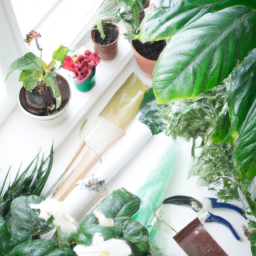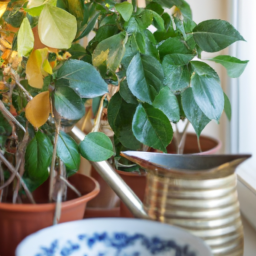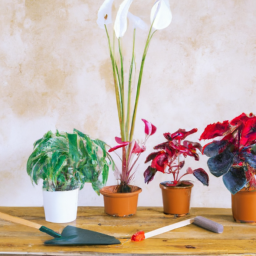
Winter Plant Care Tips: Nurturing Plants Through the Cold
As the temperature drops and the days become shorter, it’s important to remember that our beloved plants need some extra care during the winter months. While some plants may go dormant or even die off completely, there are steps we can take to ensure their survival and help them thrive come springtime. In this blog post, we will explore some winter plant care tips that will help you nurture your plants through the cold and keep them healthy and happy until the warmer days return. Whether you’re a seasoned gardener or just starting out, these tips will provide you with the knowledge and confidence to protect your plants during the harsh winter season. So grab a cup of hot cocoa, bundle up, and let’s dive into the world of winter plant care!
Importance of Winter Plant Care: Ensuring Healthy Growth and Survival
Winter can be a challenging season for plants, as the cold temperatures and harsh weather conditions can take a toll on their health and survival. However, with proper care and attention, you can ensure that your plants not only survive but thrive during the winter months. In this article, we will discuss the importance of winter plant care and provide you with valuable tips to nurture your plants through the cold.
Understanding the Impact of Winter on Plants
Before we delve into the tips for winter plant care, it is essential to understand how winter affects plants. The cold temperatures can cause damage to plant tissues, leading to wilting, browning of leaves, and even death. Additionally, frost can freeze the water inside the plant cells, causing them to burst and further damage the plant.
Furthermore, winter also brings reduced sunlight and moisture levels, which can hinder the growth and development of plants. Without proper care, plants may become weak, susceptible to diseases, and less likely to survive until spring.
Now that we are aware of the challenges plants face during winter let’s explore some crucial tips for nurturing them through the cold.
1. Provide Adequate Protection
The first step in winter plant care is to provide adequate protection to shield your plants from harsh weather conditions. Start by adding a layer of mulch around the base of your plants. Mulch acts as an insulator, protecting the roots from extreme cold and temperature fluctuations. It also helps retain moisture in the soil.
For potted plants, consider moving them to a sheltered area, such as a greenhouse or a covered porch. This will provide them with additional protection from cold winds and frost.
2. Watering Wisely
While it may seem counterintuitive, watering your plants during winter is crucial. However, it is essential to water them wisely. The key is to water deeply but infrequently. This will ensure that the roots receive enough moisture without becoming waterlogged, which can lead to root rot.
Monitor the moisture levels in the soil regularly and water only when necessary. Remember, plants require less water during winter due to reduced evaporation rates and slower growth.
3. Pruning and Maintenance
Winter is an excellent time to prune your plants and remove any dead or damaged branches. Pruning helps improve air circulation and reduces the risk of fungal diseases. Additionally, removing dead foliage and flowers will redirect the plant’s energy towards healthy growth in the coming spring.
Inspect your plants regularly and remove any fallen leaves or debris around them. This will prevent pests and diseases from taking hold during the winter months.
Conclusion
Winter plant care is essential for ensuring the healthy growth and survival of your plants. By providing adequate protection, watering wisely, and performing regular pruning and maintenance, you can help your plants thrive even in the harshest winter conditions. Remember to monitor your plants closely and make adjustments as necessary. With proper care, your plants will not only survive but also flourish, ready to greet the arrival of spring with renewed beauty.

Essential Tips for Protecting Plants from Frost and Freezing Temperatures
Understanding Frost and Freezing Temperatures
Before we dive into the essential tips for protecting plants from frost and freezing temperatures, it’s important to understand what these conditions entail. Frost occurs when the temperature drops below freezing, causing moisture in the air to freeze and form ice crystals. Freezing temperatures, on the other hand, refer to any temperature below the freezing point of water, which is 32 degrees Fahrenheit (0 degrees Celsius).
Both frost and freezing temperatures can be detrimental to plants, as they can damage or kill delicate plant tissues. Therefore, it’s crucial to take necessary precautions to protect your plants during the winter months.
Now, let’s explore some essential tips for nurturing your plants through the cold:
1. Choose Cold-Hardy Plants
One of the best ways to ensure your plants survive the winter is to select cold-hardy varieties that are well-suited for your climate. Different plants have different tolerances to cold temperatures, so it’s important to do some research and choose plants that can withstand the winter conditions in your area. Native plants are often excellent choices, as they have adapted to the local climate over time.
When selecting cold-hardy plants, consider factors such as hardiness zones, which indicate the average minimum temperature in a specific region. The United States Department of Agriculture (USDA) provides a useful hardiness zone map that can help you determine which plants are suitable for your area.
By choosing cold-hardy plants, you’re giving them a better chance of surviving and thriving during the winter months.
2. Provide Proper Insulation
Insulation is key when it comes to protecting plants from frost and freezing temperatures. There are several ways you can provide insulation for your plants:
– Mulching: Apply a layer of organic mulch around the base of your plants to help insulate their roots. Mulch acts as a protective barrier, reducing temperature fluctuations and preventing moisture loss.
– Covering: Use frost blankets, burlap, or old bedsheets to cover delicate plants overnight when frost or freezing temperatures are expected. Make sure the cover reaches the ground to trap heat emanating from the soil.
– Creating windbreaks: Install temporary windbreaks, such as fences or screens, to shield your plants from cold winds. Wind can strip away heat from plants, making them more susceptible to frost damage.
Proper insulation will help maintain a more stable and favorable microclimate around your plants, shielding them from harsh winter conditions.
3. Watering and Hydration
Watering is an important aspect of winter plant care, but it requires some adjustments compared to other seasons. Here are some tips to keep in mind:
– Reduce watering frequency: As plants enter dormancy during winter, their water requirements decrease. Water your plants less frequently, allowing the soil to dry out slightly between waterings. Overwatering can lead to root rot, especially when the soil doesn’t have enough time to dry out between watering sessions.
– Water during the day: Whenever possible, water your plants during the day when temperatures are warmer. This allows the plants to absorb moisture and reduces the risk of freezing at night.
– Avoid wet foliage: Try to water the soil directly instead of wetting the foliage. Wet leaves and stems are more prone to frost damage, so it’s best to keep them dry.
Proper watering practices ensure that your plants stay hydrated without exposing them to unnecessary risks during the winter months.
4. Pruning and Maintenance
Before winter arrives, it’s essential to prepare your plants through proper pruning and maintenance. Here’s what you should do:
– Remove dead or diseased branches: Prune away any dead or diseased branches to prevent further damage during winter. These branches are more susceptible to breaking under the weight of snow or ice.
– Trim back plants sensibly: Some plants benefit from selective pruning to reduce their overall size and prevent wind damage. However, avoid heavy pruning, as it can stimulate new growth that is more vulnerable to frost damage.
– Clean up debris: Clear fallen leaves and other debris from around your plants. Decaying organic matter can harbor pests and diseases that might affect your plants’ health.
By pruning and maintaining your plants properly, you’re improving their overall resilience and reducing the risk of winter damage.
5. Monitor and Protect Root Systems
While it’s important to protect the above-ground parts of your plants, don’t forget about their root systems. Here’s what you can do:
– Apply a layer of mulch: As mentioned earlier, mulching helps insulate the roots and maintain a more stable soil temperature. Apply a thick layer of mulch around the base of your plants, extending it beyond the drip line.
– Consider container plants: If you have potted plants, their root systems are more exposed to cold temperatures. Move them to a sheltered location, such as a garage or basement, or wrap the containers with insulating materials.
– Monitor soil moisture: Check the moisture levels in the soil regularly. While you want to avoid overwatering, you also don’t want the soil to completely dry out. Moist soil retains heat better than dry soil.
By paying attention to the root systems, you’re ensuring that your plants have a strong foundation to withstand the challenges of winter.
Conclusion
Protecting your plants from frost and freezing temperatures is crucial for their survival and overall health. By choosing cold-hardy plants, providing proper insulation, adjusting watering practices, pruning and maintaining your plants, and monitoring their root systems, you can effectively nurture your plants through the cold winter months.
Remember, each plant is unique, so it’s essential to understand their specific needs and adapt your care accordingly. With these essential tips in mind, you’ll be well-prepared to protect and nurture your plants through the winter season.

Nurturing Plants Indoors: Creating a Suitable Environment for Winter Growth
Introduction
During the winter months, many plants struggle to survive the harsh conditions outdoors. However, with a little extra care and attention, you can create a suitable environment indoors to nurture your plants and ensure their winter growth. In this guide, we will provide you with step-by-step tips on how to create the perfect indoor environment for your plants during the cold season.
1. Choosing the Right Location
The first step in nurturing plants indoors is to select the right location for them. Look for a spot in your home that receives adequate sunlight, preferably a south-facing window. Sunlight is crucial for plants’ growth and survival, especially during the winter when daylight hours are shorter. If you don’t have a sunny window, you can use artificial grow lights to supplement the light requirements of your plants.
Additionally, consider the temperature of the chosen location. Most plants prefer temperatures between 60-75°F (15-24°C). Avoid placing them near drafty windows, heating vents, or areas with extreme temperature fluctuations.
Lastly, ensure that the chosen location has enough space to accommodate your plants. They should have room to grow and spread their roots comfortably.
2. Providing Adequate Humidity
Indoor environments tend to be drier during the winter due to artificial heating systems. This can negatively impact your plants, as many of them thrive in higher humidity levels. To provide adequate humidity, consider the following:
– Group your plants together: Placing plants in close proximity creates a microclimate that helps to increase humidity levels around them.
– Use a humidifier: If the air in your home is excessively dry, using a humidifier can help maintain the desired humidity level for your plants.
– Mist your plants: Regularly misting your plants with water can mimic natural humidity and provide a moisture boost.
– Create a pebble tray: Fill a tray with water and place pebbles or stones in it. Set your plant pots on top of the pebbles, ensuring that the water does not touch the bottom of the pots. As the water evaporates, it increases humidity around the plants.
3. Proper Watering Techniques
Watering your plants correctly is crucial for their winter growth. Here are some important watering tips to keep in mind:
– Check soil moisture: Before watering your plants, check the moisture level of the soil. Stick your finger about an inch deep into the soil; if it feels dry, it’s time to water.
– Water thoroughly: When watering, ensure that you thoroughly wet the entire root ball. This encourages deep root growth and prevents waterlogging.
– Avoid overwatering: Overwatering can lead to root rot and other fungal diseases. Always allow the top inch of soil to dry out before watering again.
– Use room temperature water: Cold water can shock the roots of your plants. Fill a watering can with room temperature water and let it sit for a few hours before using it.
4. Maintaining Proper Air Circulation
Proper air circulation is essential for preventing the buildup of stagnant air and reducing the risk of pests and diseases. Here’s how you can ensure good air circulation:
– Avoid overcrowding: Give your plants enough space to breathe by placing them at a reasonable distance from each other.
– Use fans: If you notice stagnant air in your indoor garden, consider using a small fan to create gentle air movement. This helps prevent the growth of mold and encourages strong plant stems.
– Open windows occasionally: On mild winter days, open your windows for a short while to allow fresh air to circulate. However, make sure to protect your plants from cold drafts.
5. Fertilizing and Pruning
While plants generally require less fertilizer during the winter, they still benefit from occasional feeding. Use a balanced, water-soluble fertilizer at half the recommended strength every 4-6 weeks. This provides essential nutrients for healthy growth.
Additionally, winter is a good time to prune your plants. Remove any dead or diseased foliage to promote new growth. Pruning also helps maintain the shape and size of your plants, ensuring they don’t become too leggy or unruly.
Conclusion
Nurturing plants indoors during the winter can be a rewarding experience. By choosing the right location, providing adequate humidity, proper watering, maintaining air circulation, and fertilizing and pruning when needed, you can create a suitable environment for your plants to thrive. Remember to observe your plants closely and make adjustments as necessary. With a little care and attention, your plants will continue to grow and flourish even during the cold winter months.
Summary Snapshot
Winter can be a challenging time for plants, as the cold weather and frost can take a toll on their health. However, with a little extra care and attention, you can help your plants survive and thrive through the winter months. One important tip is to protect your plants from freezing temperatures by covering them with blankets or burlap. This will provide insulation and shield them from the harsh elements. Additionally, it’s crucial to water your plants properly during winter. While they may not need as much water as they do in the warmer months, it’s still important to keep the soil moist. Be sure to water early in the day to allow time for the excess moisture to evaporate before nighttime, as wet soil can freeze and damage the roots. Finally, don’t forget to prune your plants during winter. This will help remove any dead or diseased branches and promote healthy growth when spring arrives.
Another essential aspect of winter plant care is providing adequate sunlight. Since the days are shorter and the sun is less intense during winter, it’s important to position your plants in areas where they can receive as much sunlight as possible. If you have potted plants, consider moving them closer to windows or using artificial grow lights to supplement their light needs. Additionally, it’s crucial to be mindful of the humidity levels in your home during winter. Indoor heating can cause the air to become dry, which can be detrimental to your plants. You can increase humidity by placing a tray of water near your plants or using a humidifier. Lastly, be cautious of overwatering your plants during winter. The combination of cold weather and slow growth can make plants more susceptible to root rot. Always check the moisture level of the soil before watering and ensure proper drainage to prevent waterlogged roots. With these simple tips, you can ensure your plants stay healthy and vibrant even during the coldest months of the year.
Your Burning Questions Answered:
Q1: What are some general tips for caring for plants during the winter?
A1: During the winter, it’s important to provide proper care to ensure your plants survive the cold. Firstly, make sure to water your plants sparingly, as they require less water in colder temperatures. Additionally, place your plants in areas with sufficient sunlight exposure to keep them healthy. Lastly, protect your plants from extreme temperature fluctuations by moving them away from drafty windows or doors.
Q2: How can I protect my outdoor plants from frost and freezing temperatures?
A2: To protect your outdoor plants from frost and freezing temperatures, consider covering them with frost blankets or old bedsheets. This will provide an extra layer of insulation and shield them from the cold. It’s also helpful to mulch around the base of the plants to retain soil warmth. Additionally, consider bringing potted plants indoors or placing them in a sheltered area to shield them from harsh weather conditions.
Q3: How often should I water my plants during winter?
A3: During winter, it’s important to adjust your watering schedule to accommodate the lower water needs of plants. Generally, you should water your plants less frequently than during other seasons. Check the soil moisture level regularly and only water when the top inch of soil feels dry. Overwatering can lead to root rot, so it’s crucial to strike a balance and avoid waterlogged soil.
Q4: Are there any specific plants that require special care during winter?
A4: Yes, certain plants require special care during winter. For example, tender plants such as tropical plants or succulents may need to be brought indoors or placed in a greenhouse to protect them from the cold. Additionally, some plants may benefit from additional insulation, like wrapping the base of their trunks with burlap or providing a windbreak. It’s essential to research the specific needs of your plants to ensure they receive the appropriate care.
Q5: Can I still fertilize my plants during winter?
A5: It’s generally not recommended to fertilize plants during winter. Most plants enter a dormant phase during this time, and their growth slows down significantly. Fertilizing can stimulate new growth, which is susceptible to damage from the cold. It’s best to wait until spring when the plants start actively growing again before resuming fertilization. However, if you have winter-blooming plants or houseplants that continue to grow, you can use a diluted, slow-release fertilizer sparingly.

James Wong is a renowned ethnobotanist, plant scientist, and local television presenter. With a passion for demystifying plant science, he is known for translating complex botanical concepts into practical advice for everyday plant enthusiasts. James’s expertise spans from traditional gardening to cutting-edge plant technologies, making his insights accessible and informative.


